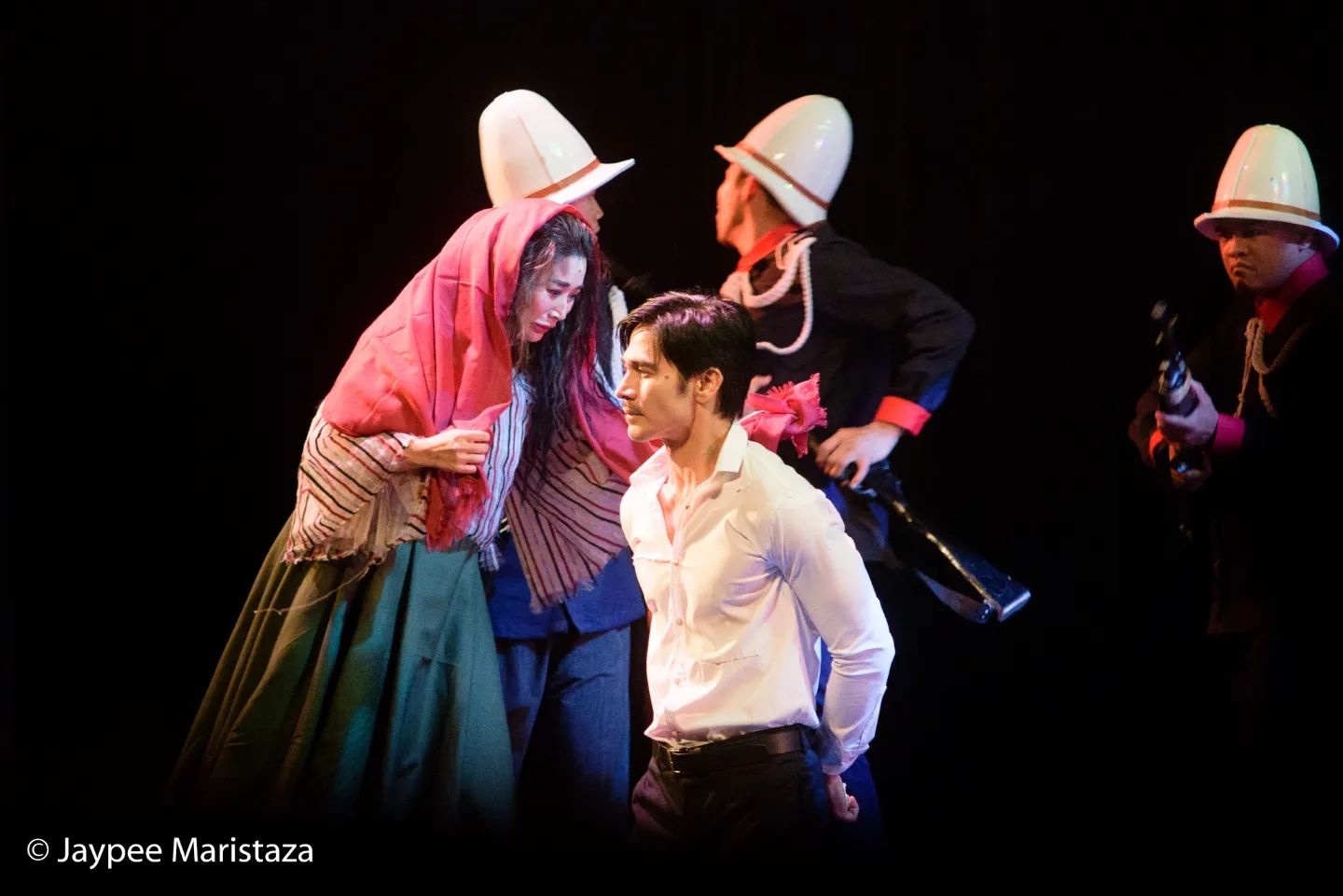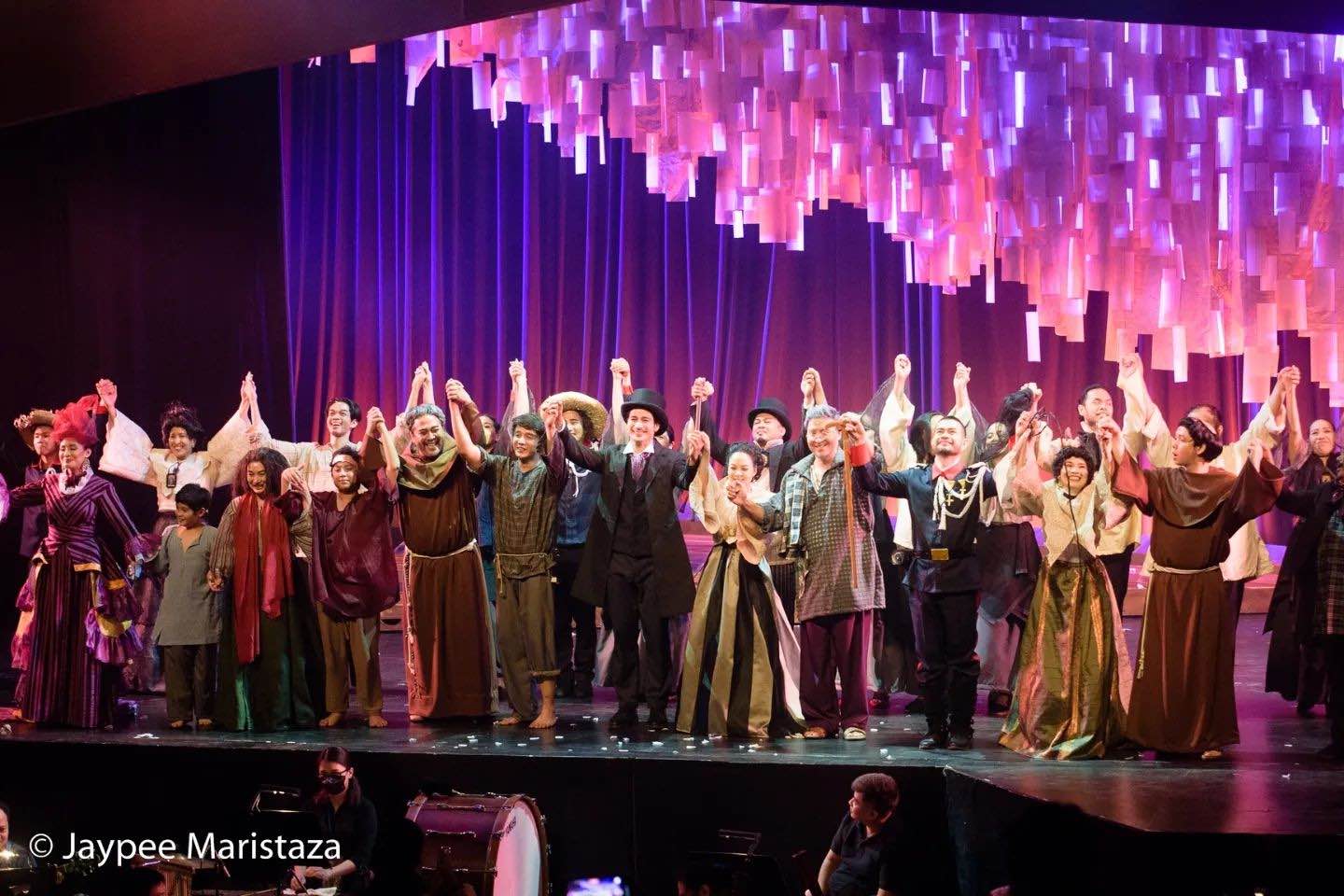REVIEW: ‘Ibarra’ carries the weight of its intertwined legacies with Rizal with grace
Legacy is always hard to square up to when creating works of art. Ibarra, whose original title was Kanser, carries on its shoulders the weight of Rizal’s legacy to Philippine history and its own as the longest-running play in the country with its 2023 staging for its 40th year. The musical manages to soar above great heights to become an engaging, evocative narrative that exemplifies the timelessness of Rizal’s work with its well-rounded aspects, powerful performances, evocative music, and simple yet effective design.
As his debut in musical theater, Piolo Pascual meets expectations as the titular character. He delivers a performance that nicely balances all the anger, idealism, and love that Ibarra has throughout his journey to achieve his father’s dream. His extended time away from stage performance, however, is evident as his physical acting is noticeably more restrained compared to his co-actors. But whatever he lacked in his physical performance, he greatly made up for in his singing segments. He manages to deliver a vocal performance with all the power that the role of such a historic piece deserves.

Pascual’s co-actors gave exemplary performances, too. The priests Padre Damaso and Salvi, played by Floyd Tena and Carlo Mañalac, respectively, were as devious as one would expect them to be, with Tena giving a weighty gravitas to Padre Damaso, and Mañalac exhibiting a particularly slimy Salvi. Elias (alternating between Kevin Posadas and Jeffrey Hidalgo) showed a young revolutionary struggling against the whims of those in power. Sisa’s children Crispin and Basilio, played by Elian Santos and JD Tena, gave outstanding performances for such young actors. The Doñas Victorina and Consolacion, played by Carla Guevara Laforteza and Meldea Chua, were playful and condescending.

Among the cast, the standout performances come from the similarly well-loved characters in Rizal’s novel, with Nicole Laurel Asensio as Sisa, Jon Joven Uy as Pilosopo Tasio, and Myramae Meneses as Maria Clara. Asensio sells the tragedy and despair that Sisa suffers throughout the narrative with exemplary acting, both in vocals and in dialogue. Uy gives Tasio a simultaneously thoughtful and comic performance that befits the character. Last but not least is Meneses—her performance ranges from strong and operatic, capturing the strife her character faces, to sweet and sincere whenever she sings with Pascual’s Ibarra. The chemistry between the two is palpable, bringing to life a love story as nearly old as the nation itself.
The music for the show was just as excellent, with the live orchestra performance by the Manila Symphony Orchestra elevating the show to a much more immersive experience. There were times, however, when the orchestra overpowered the actor’s vocals, making it hard to parse out what they were singing. Ultimately, this didn’t detract too much as the actors were still able to clearly evoke what their characters meant in the scene. Joed Balsamo’s music and Jomar Fleras’ writing continue to captivate hearts and minds, even at the show’s 40th staging.

Of these pieces, Mga Liham at Lihim was perhaps the diamond among precious stones. As a large ensemble number, it evokes the old proverb: “The pen is mightier than the sword.” In it, we find Ibarra, Elias, Salvi, and Maria clutching letters that have fundamentally changed not only their lives, but that of those around them and the bayan they live in. As a novelist whose works rallied the Filipino people to throw off the yoke of Spanish colonialism, Rizal is a figure for whom this proverb rings truest.
Another exemplary song in the musical was the somber duet between Maria Clara and Sisa, whose lives have been torn apart by the cancer of the society they live in. Maria Clara, whose love became devoted to addressing and fighting it, comes to lose him to it as he succumbs to the corruption of those in power that seek to destroy him and his father’s legacy. Sisa, whose children were left to the mercy of a corrupt church and merciless guwardiya sibil, mentally breaks. This performance is the most lucid we see her after losing her sons, before her final reunion with Basilio in the final act. This scene is strengthened further by the mirror frame set piece, with Maria Clara and Sisa on each side of it, as the true mirrors of each other they are.
The show’s design by Mio Infante (production design) and Dong Calingacion (lighting design) are the final pieces that make the show such a wonderful experience to watch. The stage is a dynamic environment that quickly and seamlessly flows through each scene in so small part—thanks to the effective use of small set pieces and props, and the large walls of wood and tulle that shift in and out throughout the show. What is most transformative in the play is the wooden ramp that starts at the back of the stage. As it progresses, though, it becomes the famous Bapor Tabo, the same boat which is then beset by a crocodile that Elias and Ibarra kill. This scene also demonstrates another stroke of symbolism, as the crocodile is represented with people wearing hoods in a line. After Ibarra lands the final blow to the crocodile, the hooded figures reveal themselves to be the actors that play the priests in the play, led by Padre Salvi.

Overall, the musical, directed by Frannie Zamora, is a great watch. It carries the weight of its intertwined legacies with grace, creating a wonderful show to remind audiences of the art that helped spark the revolution which led to the independence we celebrate this month.



